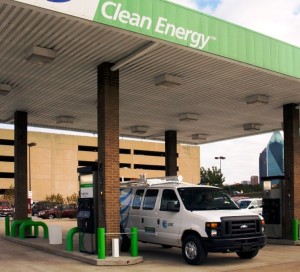AT&T’s plans to spend $350 million to purchase compressed natural gas vehicles moved forward today as Clean Energy Fuels Corporation (Nasdaq: CLNE) said it would build and run the CNG fueling stations required.
At 8,000 vehicles, this is the largest corporate commitment to CNG vehicles to date in the U.S., and is part of a $565 million, long-term strategy at AT&T to deploy more than 15,000 alternative-fuel vehicles by 2019.
“AT&T’s commitment to alternative-fuel vehicles reflects our long-term goal to minimize dependence on imported sources of fuel and explore new automotive technologies,” said Charlene Lake, AT&T chief sustainability officer.
Last year at the start of the program, AT&T purchased 600 Ford E-Series vans converted CNG fuel from Dallas-based BAF Technologies, which is owned by Clean Energy. The CNG vehicles will be used to provide and maintain communications services for AT&T customers.
Proponents of CNG claim that the fuel results in lower emissions since natural gas contains less carbon than any other fossil fuel, and, therefore, produces lower CO2 emissions per vehicle mile traveled.
However, natural gas contains methane, another principal greenhouse gas. Methane traps more than 20 times as much heat as carbon and accelerates climate change. Proponents claim that the increase in methane emissions from the use of natural gas is offset by a substantial reduction in CO2 emissions compared to other fuels.
The California Air Resources Board (CARB) in a study concluded that burning compressed natural gas produces about 22% less GHGs than burning diesel, and 29% less than burning gasoline. (See Boxer Blasts Diesel Use at Senate Hearing.)
The EPA is now conducting independent review of how it should calculate the life-cycle effects of renewable fuels on air pollution.
Normally this would be an arcane economic debate over methodologies, time periods, and at what rate to calculate/discount the value of gains over time. But at stake here, ultimately, is billions of dollars in taxpayer subsidies to agribusiness, and even the future of the whole bio-fuels industry in the U.S.
So a controversy has been growing among various self-interested factions since the EPA, under the Obama Administration, reversed its Bush-directed self and said greenhouse gases are a health problem, which will be addressed.
A contentious rulemaking process is now well underway at EPA
From an automotive point of view there are two central issues.
- The first is how to decrease emissions and our dependence on imports of foreign oil from terrorist supporting countries.
The second is a subset of the first: what if the biofuels we are using — ethanol, biodiesel, natural gas — really cause more emissions than they save? That’s why how the EPA calculates the life cycle emissions effects is of such concern to subsidized businesses, the agricultural lobby and various clean air special interest groups.
The U.S. is already under Congressional mandate to use increasing amounts of renewable fuels. Under the Energy Independence and Security Act of 2007, EPA is responsible for revising and implementing regulations to ensure that gasoline sold in the United States contains a minimum volume of renewables. The Renewable Fuel Standard program will increase the volume of renewable fuel required to be blended into gasoline from 9 billion gallons in 2008 to 36 billion gallons by 2022. (At one point the goal under President Bush was 35 billion/2017.)
The new RFS program regulations are being developed with what the EPA euphemistically says is a “collaboration with refiners, renewable fuel producers, and many other stakeholders.” Translation: Big bucks are at stake here, and lobbying will be intense.
“Clean Energy stands ready to support this and other fleet commitments to natural gas fuel with advanced fueling infrastructure and services around the country,” said James Harger, the Chief Marketing Officer of the natural gas provider founded by Boone Pickens.
Clean Energy already has a large customer base in the refuse, transit, ports, shuttle, taxi, trucking, airport and municipal fleet markets, fueling more than 17,800 vehicles at 196 strategic locations across the United States and Canada.
Clean Energy also owns and operates two LNG production plants, one in Willis, TX and one in Boron, CA, with combined capacity of 260,000 LNG gallons per day and designed to expand to 340,000 LNG gallons per day as demand increases.


Are you sure natural gas produces methane? I think it is methane, but after you burn it it becomes water and carbondioxide… Maybe if the engine does not burn 100% of the methane you might say it emits methane. I drive a CNG car, but it does never smell of gas.
Completely burned, natural gas, which consists largely of methane, produces CO2 and water.
I should have made it clearer that the production of natural gas and its handling is the methane issue.